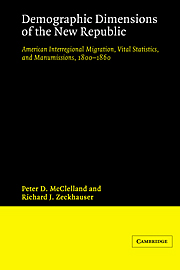 Demographic Dimensions of the New Republic
Demographic Dimensions of the New Republic Book contents
- Frontmatter
- Contents
- List of tables
- Preface
- Map 1 Regions of the United States
- 1 Introduction and summary
- 2 Migration model: closed population
- 3 Migration model: adjustments for international migration
- 4 Interregional migration estimates 1800–60
- 5 White population: birth rates, death rates, and rates of natural increase
- 6 Negro population: birth rates, death rates, rates of natural increase, and manumissions
- 7 Conclusions
- Appendixes
- Notes
- Bibliography
- Index
6 - Negro population: birth rates, death rates, rates of natural increase, and manumissions
Published online by Cambridge University Press: 19 September 2009
- Frontmatter
- Contents
- List of tables
- Preface
- Map 1 Regions of the United States
- 1 Introduction and summary
- 2 Migration model: closed population
- 3 Migration model: adjustments for international migration
- 4 Interregional migration estimates 1800–60
- 5 White population: birth rates, death rates, and rates of natural increase
- 6 Negro population: birth rates, death rates, rates of natural increase, and manumissions
- 7 Conclusions
- Appendixes
- Notes
- Bibliography
- Index
Summary
Overview 1800–60
The marked decline in the observed rate of growth of the American Negro population in the period 1800–60 has been a continual puzzle for historians and demographers. From a high of 38 percent in the decade 1800–10, the growth rate declined to 22 percent in the decade 1850–60. (See Table B-l.) ‘Neither demographic data nor contemporary accounts of living conditions satisfactorily explain why the growth rate tapered off.’ The explanation can only be in terms of falling immigration, rising death rates or declining birth rates. Section 3.6 indicated the tenuous nature of the historical evidence concerning the magnitude and trend of slave smuggling. Evidence on vital statistics is almost as elusive.
The birth rate of slaves was undoubtedly ‘high’ throughout the ante-bellum period. Historians have not infrequently claimed that their housing arrangements and loose family structure favored ‘widespread sexual promiscuity’, a tendency that was hardly discouraged by white owners who had, in the discreet wording of Ulrich Phillips, ‘everywhere and at all times an interest in the multiplication of their slaves’. This interest occasionally manifested itself in specific incentives offered to prospective mothers: labor exemptions during pregnancy sometimes with the added bonus of better food and clothing; in some cases, complete exemption from field work for women with six or more healthy children. Two conclusions follow.
- Type
- Chapter
- Information
- Demographic Dimensions of the New RepublicAmerican Interregional Migration, Vital Statistics and Manumissions 1800-1860, pp. 73 - 83Publisher: Cambridge University PressPrint publication year: 1983


